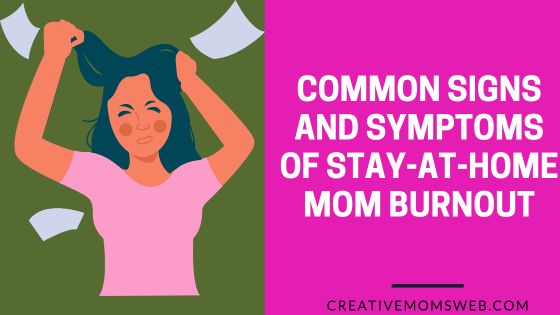Being a stay-at-home mom is a beautiful and fulfilling journey, but it also comes with its fair share of challenges. The demands of constant caregiving, household responsibilities, and the absence of personal time can take a toll on your well-being. One critical aspect to be mindful of is stay-at-home mom burnout, which can have a profound impact on your physical, emotional, and mental health. In this blog post, we will explore common signs and symptoms of stay-at-home mom burnout to help you recognize and address it proactively. By understanding these signs, you can take steps toward reclaiming your balance and well-being.

Common signs and symptoms of stay-at-home mom burnout
1. Constant Exhaustion:
One of the primary signs of stay-at-home mom burnout is a persistent feeling of exhaustion that doesn’t seem to go away, regardless of how much rest you get. It’s not the typical tiredness that can be resolved with a good night’s sleep; instead, it feels like chronic fatigue that affects your daily functioning.
2. Irritability and Mood Swings:
If you find yourself becoming easily irritated or experiencing frequent mood swings, it could be a sign of burnout. You may notice that you’re more short-tempered than usual, and even small things can trigger strong emotional responses.
3. Loss of Interest and Motivation:
stay-at-home mom burnout often leads to a significant decline in interest and motivation. You may find yourself losing enthusiasm for activities that used to bring you joy. The things that once fueled your passion and excitement now feel like burdensome tasks.
4. Neglecting Self-Care:
When burnout sets in, self-care tends to take a backseat. You may find it challenging to prioritize your own well-being and neglect activities that bring you relaxation or fulfillment. This can further exacerbate burnout and leave you feeling depleted.
5. Physical Symptoms:
Burnout can manifest in various physical symptoms, including headaches, muscle tension, digestive issues, and frequent illnesses. These physical manifestations are your body’s way of signaling that it’s overwhelmed and in need of rest and care.
6. Social Withdrawal:
Another sign of stay-at-home mom burnout is a tendency to withdraw from social interactions. You may find yourself canceling plans, avoiding gatherings, or feeling isolated from friends and loved ones. Emotional exhaustion may make it difficult to engage in social activities.
7. Negative Self-Talk and Self-Doubt:
When experiencing burnout, negative self-talk and self-doubt often become more prevalent. You may find yourself questioning your abilities as a mother, feeling guilty for not meeting perceived expectations, or doubting your worth and value.
Watch the video
Here’s a list of items that can help alleviate stay-at-home mom burnout:
- Self-Care Products: Invest in self-care items like bath bombs, essential oils, face masks, or body scrubs for relaxation.
- Comfortable Loungewear: Get cozy loungewear or pajamas to feel comfortable and relaxed at home.
- Healthy Snacks: Stock up on nutritious snacks like fruits, nuts, yogurt, or granola bars for quick energy boosts.
- Herbal Teas: Keep a variety of herbal teas on hand for soothing and calming moments throughout the day.
- Exercise Equipment: Consider purchasing exercise equipment such as yoga mats, resistance bands, or dumbbells for at-home workouts. Read exercise equipment for home workout
- Mindfulness Resources: Explore mindfulness apps, books, or guided meditations to help manage stress and promote relaxation. Download apps like Headspace or Calm for guided meditation sessions tailored to your needs and preferences.
- Planners or Organizers: Use planners or organizers to schedule self-care activities, prioritize tasks, and create a sense of structure.
- Supportive Community: Seek support from online forums, social media groups, or local meetups for stay-at-home moms to connect with others facing similar challenges. Read stay-at-home mom group
- Childcare Assistance: Arrange for occasional childcare or playdates to take breaks and recharge.
- Therapeutic Tools: Consider therapy or counseling sessions to explore and address underlying causes of burnout with a professional.
These items can help you create a nurturing environment and prioritize self-care, ultimately reducing burnout and promoting overall well-being as a stay-at-home mom.
Conclusion: Recognizing the signs of stay-at-home mom burnout is the first step towards addressing it and reclaiming your well-being. If you resonate with any of these signs, know that you’re not alone and that help is available. It’s crucial to prioritize self-care, seek support from loved ones or professionals, and establish healthy boundaries. By addressing burnout proactively, you can regain balance, rediscover the joy in your role as a stay-at-home mom, and nurture your own well-being along the way. Remember, taking care of yourself is essential for providing the best care for your loved ones.
